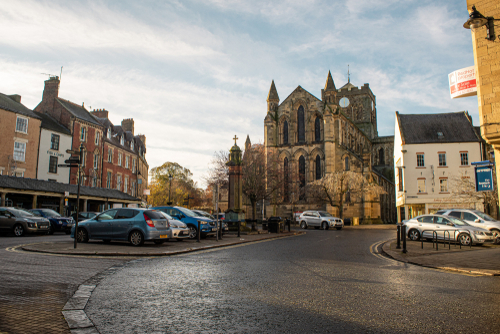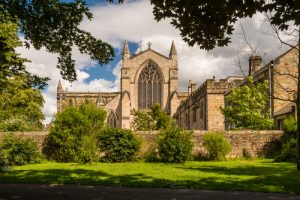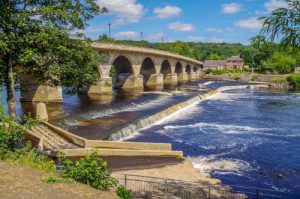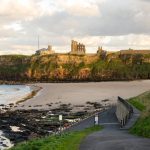
Hexham is a small market town and civil parish in the southwest of Northumberland (aka Northumbria) in the North of England. The town is situated close to the world-renowned Hadrian’s Wall about 25 miles (40 km) east of Newcastle and 37 miles (60 km) west of Carlisle. It also stands on the south bank of the River Tyne, close to the confluence of the North Tyne and South Tyne rivers. Hexham’s history is indelibly linked with its status as a major ecclesiastical centre in the 900 years between the 7th and 16th centuries.

Image: Dave Head/Shutterstock.com
A Bit Of Hexham History
There are archaeological findings to suggest that the area around Hexham was inhabited in both the Neolithic and Bronze Ages. However, though Hexham lies close to Hadrian’s Wall and the important Roman township of Corbridge, there is no clear evidence to substantiate the notion that the town was ever settled during the Roman Era.
The first documented reference to Hexham occurred in AD 674 when land known as Hestaldesham was granted to Wilfred, Bishop of York, by Queen Ethelrid of Northumberland, for the purpose of building a monastery. By AD 678, Wilfred had founded Hexham’s Priory Church of St Andrew’s. In AD 681, the church was upgraded to a cathedral, with Eata becoming the inaugural Bishop.
In 788, the Anglo-Saxon Chronicle records that King Ælfwald was murdered by Sicga at Scythlecester, which many historians believe to be Chesters Fort. It’s then supposed that his body was brought the 6 miles from the fort, near the village of Walwick to be buried at Hexham Church.
In 821, Bishop Tidfrith of Hexham died in office, but due to the region’s then instability, a new appointment to the position was never made. Instead, the bishopric control of the area shifted to Lindisfarne, as Northumberland succumbed to the Viking invasion. In 875, large parts of the monastery were destroyed by a particular Viking raid. Little more than St Winifred’s Crypt beneath the church survived the attack.
Sometime during the 11th century, the Liberty (or Regality) of Hexhamshire was established, which consisted of about 92 sq. miles of land centred around Hexham. It was granted to the church and recognised as being a separate entity from the rest of Northumberland. Until about 1100, the Liberty was under the jurisdiction of the Bishop of Durham but duly transferred to that of the Archbishop of York – an association that continued until 1837.
In 1113, the Archbishop of York, Thomas II, re-formed Hexham’s church as a ‘Priory of Canons Regular of St Augustine’, granting it land and properties. In 1189, the church was largely rebuilt by the Augustinian monks. In the mid 13th century. a gatehouse was added to the Priory as fortification became increasingly important to ward off the marauding Scots.
William Wallace Pays A Visit
In 1297, Hexham was subject to an attack led by William Wallace, which saw much of the town being burnt down. In 1312, the town and monastery were spared a similar fate from another Scots incursion. However, this time, the Scots, led by Robert the Bruce, collected a £2000 protection fee before standing down from the attack. Around 1330, Britain’s first purpose-built goal was built at Hexham on the order of William Melton, the Archbishop of York. The robust building still stands in the town today and is a major tourist attraction.
The town’s monastery was ransacked again in 1346, this time by King David II of Scotland. For the next two centuries, like many towns in the Anglo-Scottish border area, Hexham was to suffer frequent raids from the notorious Border Reivers.
In 1464, the Battle of Hexham took place just south of the town during the Wars of the Roses. The Yorkists, led by John Neville, routed the Lancastrian forces in a skirmish that turned out to be the House of Lancaster’s last serious stand. Thirty of the identified leaders of the Lancastrian army, including Henry Beaufort, the Duke of Somerset, were executed in Hexham’s Market Place the following evening.
In 1536, following Henry VIII’s Dissolution of the Monasteries, Hexham Abbey was relegated to the status of the parish church. In 1572, Hexham lost further influence as its role as the administrative centre for Hexhamshire ceased, due to the ‘Liberty’ being incorporated back into Northumberland. However, in 1599, there was some positive development when Hexham Grammar School was founded.
Seventeenth-Century Hexham
By the 17th century, a significant leather industry had developed in Hexham. The town’s relative remote rural location made it an ideal centre for the processing of animal hides and skins that were bought up from farmers in the surrounding countryside. A number of tanneries were situated in the town’s Burn Lane and High Shield areas.
In 1715, James Radclyffe, 3rd Earl of Derwentwater, ran up the standard of James Francis Edward Stuart (The Old Pretender) in Hexham’s Market Place. However, the Jacobite Rising, as it became known, an attempt to recapture the British throne for the House of Stuart, proved to be unsuccessful. Derwentwater was captured after the Battle of Preston and incarcerated in the Tower of London. He was subsequently beheaded along with some of his other co-conspirators on 24th February 1716.

Hexham Bridge crossing the River Tyne (1793)
In 1761, there were more woes for the town when the ‘Hexham Riot’ broke out. A crowd protesting about changes brought about for serving in the military were fired on by troops from a North Yorkshire Militia. Fifty-one protesters were killed, which saw the Yorkshire militiamen being dubbed ”The Hexham Butchers”.
In 1770, the first Bridge across the River Tyne was completed but was washed away in the Great Tyne Flood only a year later. Work on a new bridge began in 1777, headed up by famed Civil Engineer, John Smeaton. The 9-arch masonry bridge was opened in 1780 but in 1782 went on to suffered the same fate as the earlier bridge. A completely new bridge at a different site was eventually built, opening in 1793. Today it’s recognised as a Grade II Listed Structure.
Rope & Leather Rule
Around 1800, a ropery was built in Argyle Terrace which saw the rope-making industry become established in the town. At the turn of the 19th century, Hexham remained an important centre of the leather trade. It was particularly renowned for making gloves known as ‘Hexham Tans’. The industrial growth of the town saw the population increase from about 4,500 to 6,000 in the period 1800 – 1830.
In 1825, the Newcastle and Carlisle Railway Company was formed with the aim of building a railway to connect the East and West coasts of northern England. Work on the railway began in 1830 with priority being given to the section between Hexham and Blaydon. This was to facilitate the transportation of lead ore extracted from the mines at Dukesfield (just south of Hexham) to the North Coast. Since, prior to the railways, it had to be transported by pony trains across the Pennines.
The Train Is In The Station
The opening of the rail line in 1835 saw an almost immediate 40% drop in the price of lead ore. The completion of the Newcastle to Carlisle railway in 1837 brought about a cheap means of transport and distribution to the entire region. However, the knock-on effect was to push rural industries into further decline.
There was some development to Hexham through the rest of the 19th century, but not on the same scale as that seen in the more urban parts of the country. A new drainage and water supply was introduced to the town in 1864, and a new Town Hall opened in 1865. However, by this time, the town’s leather industry was more or less finished. While in 1885, the Hexham UK Parliament constituency was created, the town’s population remained stagnant, being similar to that of 1830, i.e. around 6,000.
In 1894, St Mary’s Church was founded and the Hexham Urban District was created. In 1911, Abbey Grounds were laid out as a public park, with the War Memorial being erected in 1920. Through the first half of the 20th century, the town’s population grew steadily, such by 1961, it had reached 9,910. In 1974, Hexham Urban District was abolished and the area was incorporated into the newly formed Tynedale District.
Modern Hexham
At the 2011 national census, Hexham had a population of 11,829.
With more than 600 employees, the Austrian company ‘Egger’ is by far Hexham’s biggest employer. The Hexham plant is one of Europe’s most advanced facilities for the production of chipboard. Fentiman’s, a botanical brewer and producer of traditional soft drinks employs more than 60 people in the town. Agriculture is also still important to the local economy. There’s a Farmers’ Market that takes place every other Saturday in the Market Place throughout the year, where produce comes from a 50 miles radius of Hexham. The service industry and tourism make up the rest of the local economy.
Hexham has a busy programme of events throughout the year, which attracts both locals and tourists to the town. The ‘Hexham Abbey Festival’ is a music and arts event that takes place over 4 days in mid-September. One of the biggest events in the town’s calendar is ‘Hexham Spook Night’. It takes place on the last Saturday in October and attracts thousands of people into the town. The event includes fancy dress competitions, fairground rides, pumpkin/turnip carving, etc. with the usual food stalls being set up. The ‘Tyne Tour’ is Europe’s largest mass participation canoeing event and takes place around Hexham’s Tyne Green area in November.
Bonfire Night and the Christmas Market are also a major event in the town. Arts events, films, plays, concerts and exhibitions also take place at the Queen’s Hall and Forum Cinema, throughout the year.
Hexham is twinned with Metzingen in Germany and Noyon in France.
Getting there
By Road
Getting to Hexham is relatively straightforward. From the west, turn off the M6 at Junction 43 at Carlisle on to the A69. From the East, take the A69 from Newcastle.
By Bus
If you plan to make the trip to Hexham by bus, then it’s best to take a National Express coach to either Carlisle or Newcastle. There’s a comprehensive local service between the two cities that stops at Hexham. The journey takes about 1 hour 20 mins from Carlisle and around 1 hour from Newcastle.
By Train
Hexham is a stop on the Carlisle to Newcastle Line operated by Northern. Trains run approximately every hour from early morning to late evening. The journey takes around 50 minutes from Carlisle and 40 minutes from Newcastle.
By Air
Newcastle International Airport is only 20 miles (36 km) away, via the A69.
Did you know?
- In 1464, following the Battle of Hexham, there was a local rumour that Margaret of Anjou, Queen Consort to Henry VI, took refuge in what became known as ‘The Queen’s Cave’, near the town. However, it proved only to be a myth, since it has long been established that Queen Margaret had actually fled to France before the battle took place.
- In Victorian times, Hexham was hardly viewed as the place to be by those from the Border Region, as the term ”Hexham”, was used as a euphemism for hell. It gave rise to some popular local expressions of the time, such as “Gang to Hexham!” and, “To Hexham wi’ you an’ ye’r whussel!”.
- Opened in 1835, to link the lead mines of the North Pennines to Blaydon’s Tyne docks, Hexham has one of the world’s oldest railway stations.
- The town is twinned with Metzingen in Germany and Noyon in France.
Notable People Associated With Hexham
A few notable people with an association to the town, include;
- Peter Doherty – is a musician, songwriter, actor, poet, writer, and artist. The notorious Pete is musically best known for co-founding The Libertines’. His other bands have included Babyshambles and Peter Doherty and the Puta Madres. He was born in Hexham in 1979.
- Rutherford Alcock (1809-1897) – was a British diplomat who was educated at Hexham Grammar School. He was the first British Consul-General to live in Japan and subsequently became the first foreigner ever to climb Mt Fuji.
- George Elliott Benson (1861-1901) – was born at Allerwash, about 6 miles from Hexham. He rose to the rank of Lieutenant Colonel in the Royal Artillery, dying as a hero at the Battle of Bakenlaagte, during the 2nd Boer War in South Africa. His statue, which was erected in 1904, stands in the town’s Beaumont Street and was paid for through public subscription.
Sport In Hexham
Hexham FC
Hexham FC is an amateur football team that currently (Sept 2020) plays in Division 1 of the Northern Football Alliance, the 8th tier of the English football system.
Other Sports
Hexham boasts two cricket clubs. Hexham Leazes first team plays in the West Tyne Senior Cricket League; while Tynedale Cricket Club’s first XI play in the North East Premier League. Golf, tennis and bowls are also popular sports played in the town.
If you like a flutter then Hexham Racecourse should be on your itinerary. Even if not then it’s worth a visit as it is often cited as the most scenic such course in the country. Surrounded by superb countryside, it’s situated 600 feet above the town. The national hunt course stages 15 scheduled race meetings throughout the year.
Hexham Golf Club – is a traditional 18-hole course set in 70 acres of tranquil parkland. With great views and a Grade 1 listed clubhouse, the course is considered by many to be one of the best in the country. Visiting players are welcome and bookings can be made through the club’s website.
Things to see and do!
There are loads of things to see and do in and around the town. Here’s some suggestions;
- Old Goal Museum – is England’s oldest purpose-built jail, which dates back to 1330. There are regular hands-on activities, exhibitions depicting Medieval life and local history. The Museum also runs Medieval Life sessions and Tudor Workshops for educational groups.
- Hexham Abbey – is a now a parish church and Grade I listed building dedicated to St Andrew. Originally built in AD 674, the current Abbey dates from the 12th century but was substantially refurbished and extended in the 19th century. The former outer monastic buildings, now form a permanent exhibition and visitor centre, telling the history of the Abbey.
- Tyne Green Country Park – is set on the banks of the River Tyne. A 15-minute walk from the town centre, the park has both walking and cycling routes west along the banks of the Tyne. There’s also a children’s play area, a picnic and BBQ space and a free car park. There is also a 9-hole golf course and the clubhouse is open to both visiting golfers and the general public alike.
- Abbey Grounds & Sele Park – which is right in the centre of town, features formal gardens, a traditional bandstand, a woodland area and an open expanse of grassland.
- The Queen’s Hall Arts Centre – is an event and exhibition space, that houses a 350-seat theatre and two galleries. It runs a full programme of music, drama, dance, film and other arts. It also houses Hexham’s library, a café and the local tourist information centre.
- Hexham Boot fair – is held on every Sunday and Bank Holiday Monday between February and December. Venued at the town’s Auction Mart, it’s one of the largest car boot sales in the North East.
Nearby
- Northumberland National Park – is the northernmost national park in England. It has an area of around 410 sq miles (1,050 sq km) and is both one of the least populated and least visited of the English National Parks. The park offers the opportunity to purse a number of outdoor activities, including walking, horse riding, bird watching, shooting and cycling. There’s a NNP office at Eastburn, South Park, Hexham.
- Hadrian’s Wall – is a UNESCO World Heritage Site and undoubtedly Britain’s greatest Roman monument. It stretches for 73 miles from the North Sea (East coast) to the Solway Firth (West coast). Hexham just happens to be close to some of the Wall’s best sites, i.e. Chesters Fort & Museum, Housesteads Fort & Museum and Corbridge Roman Town.
Where to stay?
Accommodation in and around Hexham is fairly limited and very much of a rustic B & B/Guesthouse/Inn style. Broadly speaking, expect to pay around £60 – £100 for 2 adults sharing per night. There’s obviously more choice a little further afield where more luxurious accommodation generally falls between £100 – £200
Thinking of moving to Hexham?
Are you thinking of moving to Hexham? The average price of a property in the town stood at £262,604 in September 2020, reflecting a fall of 2.6% in the last 12 months. In terms of the different property types in the town, the average asking price of a flat is currently £146,800, a terraced house £194,100 and a semi-detached house £219,500.
So there you have it our Five Minute Overview of this picturesque market town. Before you go why not try some of our other quizzes or have a look at some of our other location guides. better still why not join our growing community it’s free and could be very rewarding going forward.



